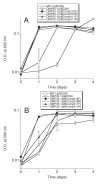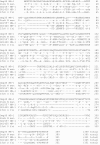The outer membrane protein Omp35 affects the reduction of Fe(III), nitrate, and fumarate by Shewanella oneidensis MR-1
- PMID: 15212692
- PMCID: PMC459216
- DOI: 10.1186/1471-2180-4-23
The outer membrane protein Omp35 affects the reduction of Fe(III), nitrate, and fumarate by Shewanella oneidensis MR-1
Abstract
Background: Shewanella oneidensis MR-1 uses several electron acceptors to support anaerobic respiration including insoluble species such as iron(III) and manganese(IV) oxides, and soluble species such as nitrate, fumarate, dimethylsulfoxide and many others. MR-1 has complex branched electron transport chains that include components in the cytoplasmic membrane, periplasm, and outer membrane (OM). Previous studies have implicated a role for anaerobically upregulated OM electron transport components in the use of insoluble electron acceptors, and have suggested that other OM components may also contribute to insoluble electron acceptor use. In this study, the role for an anaerobically upregulated 35-kDa OM protein (Omp35) in the use of anaerobic electron acceptors was explored.
Results: Omp35 was purified from the OM of anaerobically grown cells, the gene encoding Omp35 was identified, and an omp35 null mutant (OMP35-1) was isolated and characterized. Although OMP35-1 grew on all electron acceptors tested, a significant lag was seen when grown on fumarate, nitrate, and Fe(III). Complementation studies confirmed that the phenotype of OMP35-1 was due to the loss of Omp35. Despite its requirement for wild-type rates of electron acceptor use, analysis of Omp35 protein and predicted sequence did not identify any electron transport moieties or predicted motifs. OMP35-1 had normal levels and distribution of known electron transport components including quinones, cytochromes, and fumarate reductase. Omp35 is related to putative porins from MR-1 and S. frigidimarina as well as to the PorA porin from Neisseria meningitidis. Subcellular fraction analysis confirmed that Omp35 is an OM protein. The seven-fold anaerobic upregulation of Omp35 is mediated post-transcriptionally.
Conclusion: Omp35 is a putative porin in the OM of MR-1 that is markedly upregulated anaerobically by a post-transcriptional mechanism. Omp35 is required for normal rates of growth on Fe(III), fumarate, and nitrate, but its absence has no effect on the use of other electron acceptors. Omp35 does not contain obvious electron transport moieties, and its absence does not alter the amounts or distribution of other known electron transport components including quinones and cytochromes. The effects of Omp35 on anaerobic electron acceptor use are therefore likely indirect. The results demonstrate the ability of non-electron transport proteins to influence anaerobic respiratory phenotypes.
Figures









Similar articles
-
Role for outer membrane cytochromes OmcA and OmcB of Shewanella putrefaciens MR-1 in reduction of manganese dioxide.Appl Environ Microbiol. 2001 Jan;67(1):260-9. doi: 10.1128/AEM.67.1.260-269.2001. Appl Environ Microbiol. 2001. PMID: 11133454 Free PMC article.
-
Shewanella oneidensis MR-1 mutants selected for their inability to produce soluble organic-Fe(III) complexes are unable to respire Fe(III) as anaerobic electron acceptor.Environ Microbiol. 2010 Apr;12(4):938-50. doi: 10.1111/j.1462-2920.2009.02137.x. Epub 2010 Jan 18. Environ Microbiol. 2010. PMID: 20089045
-
Shewanella oneidensis MR-1 restores menaquinone synthesis to a menaquinone-negative mutant.Appl Environ Microbiol. 2004 Sep;70(9):5415-25. doi: 10.1128/AEM.70.9.5415-5425.2004. Appl Environ Microbiol. 2004. PMID: 15345428 Free PMC article.
-
Dissimilatory Fe(III) and Mn(IV) reduction.Adv Microb Physiol. 2004;49:219-86. doi: 10.1016/S0065-2911(04)49005-5. Adv Microb Physiol. 2004. PMID: 15518832 Review.
-
The membrane-bound tetrahaem c-type cytochrome CymA interacts directly with the soluble fumarate reductase in Shewanella.Biochem Soc Trans. 2002 Aug;30(4):658-62. doi: 10.1042/bst0300658. Biochem Soc Trans. 2002. PMID: 12196158 Review.
Cited by
-
Discovering cis-regulatory RNAs in Shewanella genomes by Support Vector Machines.PLoS Comput Biol. 2009 Apr;5(4):e1000338. doi: 10.1371/journal.pcbi.1000338. Epub 2009 Apr 3. PLoS Comput Biol. 2009. PMID: 19343219 Free PMC article.
-
Positive regulation of the Shewanella oneidensis OmpS38, a major porin facilitating anaerobic respiration, by Crp and Fur.Sci Rep. 2015 Sep 18;5:14263. doi: 10.1038/srep14263. Sci Rep. 2015. PMID: 26381456 Free PMC article.
-
Bacterial decolorization of textile dyes is an extracellular process requiring a multicomponent electron transfer pathway.Microb Biotechnol. 2008 Jan;1(1):40-52. doi: 10.1111/j.1751-7915.2007.00005.x. Microb Biotechnol. 2008. PMID: 21261820 Free PMC article.
-
A novel Geobacteraceae-specific outer membrane protein J (OmpJ) is essential for electron transport to Fe(III) and Mn(IV) oxides in Geobacter sulfurreducens.BMC Microbiol. 2005 Jul 6;5:41. doi: 10.1186/1471-2180-5-41. BMC Microbiol. 2005. PMID: 16000176 Free PMC article.
-
Network-Based Methods for Identifying Key Active Proteins in the Extracellular Electron Transfer Process in Shewanella oneidensis MR-1.Genes (Basel). 2018 Jan 16;9(1):41. doi: 10.3390/genes9010041. Genes (Basel). 2018. PMID: 29337910 Free PMC article.
References
Publication types
MeSH terms
Substances
Grants and funding
LinkOut - more resources
Full Text Sources

